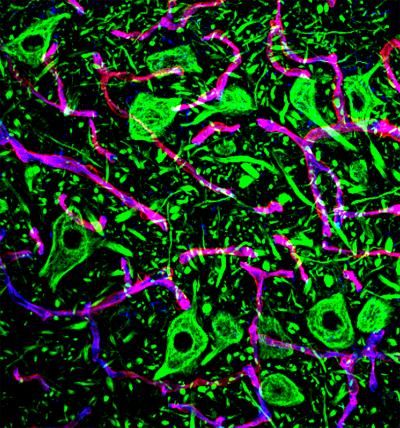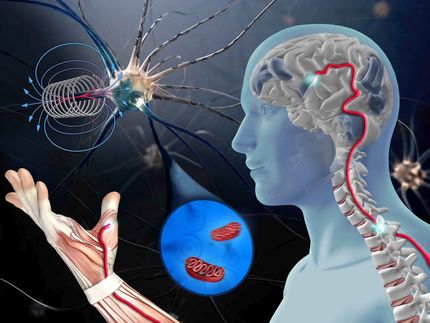Stroke drug also shows promise for people with Lou Gehrig's disease
Advertisement
Keck School of Medicine of USC neuroscientists have unlocked a piece of the puzzle in the fight against Lou Gehrig's disease, a debilitating neurological disorder that robs people of their motor skills. Their findings appear in the online edition of the Proceedings of the National Academy of Sciences of the United States of America, the official scientific journal of the U.S. National Academy of Sciences.

A fluorescent image shows cells of the neurovascular unit in the mouse spinal cord, which consists of motor neurons (green) and blood vessels containing pericytes (red) and endothelial cells (blue). Winkler et al. (2014) show that disruption of blood vessels accelerates injury of motor neurons in amyotrophic lateral sclerosis.
Ethan A. Winkler and Berislav V. Zlokovic/University of Southern California
"We know that both people and transgenic rodents afflicted with this disease develop spontaneous breakdown of the blood-spinal cord barrier, but how these microscopic lesions affect the development of the disease has been unclear," said Berislav V. Zlokovic, M.D., Ph.D., the study's principal investigator and director of the Zilkha Neurogenetic Institute at USC. "In this study, we show that early motor neuron dysfunction related to the disease in mice is proportional to the degree of damage to the blood-spinal cord barrier and that restoring the integrity of the barrier delays motor neuron degeneration. We are hopeful that we can apply these findings to the corresponding disease mechanism in people. "
In this study, Zlokovic and colleagues found that an experimental drug now being studied in human stroke patients appears to protect the blood-spinal cord barrier's integrity in mice and delay motor neuron impairment and degeneration. The drug, an activated protein C analog called 3K3A-APC, was developed by Zlokovic's start-up biotechnology company, ZZ Biotech.
Lou Gehrig's disease, also called amyotrophic lateral sclerosis, or ALS, attacks motor neurons, which are cells that control the muscles. The progressive degeneration of the motor neurons in ALS eventually leads to paralysis and difficulty breathing, eating and swallowing.
According to The ALS Association, approximately 15 people in the United States are diagnosed with ALS every day. It is estimated that as many as 30,000 Americans live with the disease. Most people who develop ALS are between the ages of 40 and 70, with an average age of 55 upon diagnosis. Life expectancy of an ALS patient averages about two to five years from the onset of symptoms.
ALS's causes are not completely understood, and no cure has yet been found. Only one Food and Drug Administration-approved drug called riluzole has been shown to prolong life by two to three months. There are, however, devices and therapies that can manage the symptoms of the disease to help people maintain as much independence as possible and prolong survival.






















































